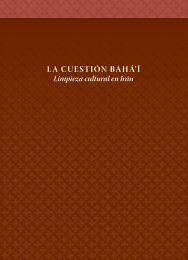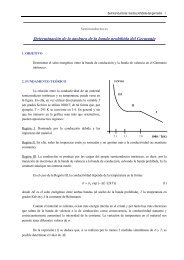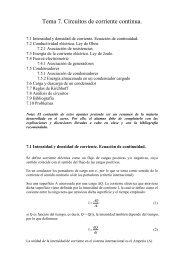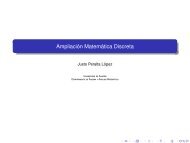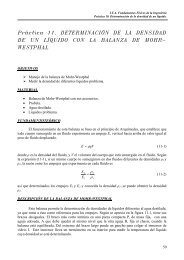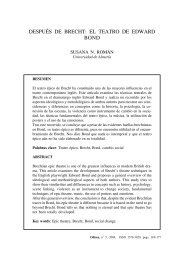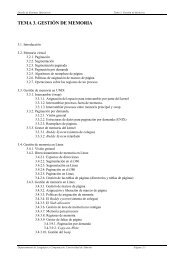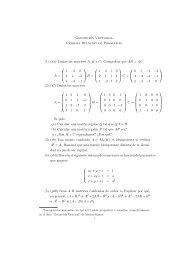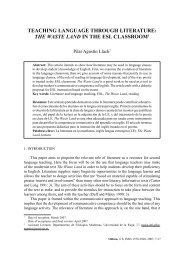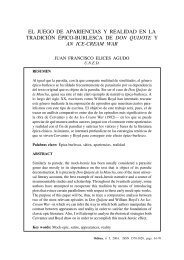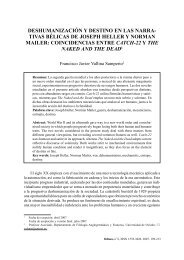Francisco José López Quintana - Universidad de AlmerÃa
Francisco José López Quintana - Universidad de AlmerÃa
Francisco José López Quintana - Universidad de AlmerÃa
Create successful ePaper yourself
Turn your PDF publications into a flip-book with our unique Google optimized e-Paper software.
LA FUNCIÓN ARTÍSTICA EN HENRY JAMES A TRAVÉS DE “THE MIDDLE YEARS”, ...<br />
35<br />
las referencias varias a la intencionalidad profunda <strong>de</strong>l texto artístico, que se fundamenta<br />
en los siguientes apartados:<br />
A) Como justificación <strong>de</strong> la vocación artística, <strong>de</strong> la actividad <strong>de</strong>l creador, <strong>de</strong>l artista, <strong>de</strong>l<br />
autor, para quien la intencionalidad <strong>de</strong> la obra es concebida como una pasión vital expuesta por<br />
medio <strong>de</strong> la frase “the very passion of the passion” (365) o también “the joy of my soul” (369).<br />
B) A<strong>de</strong>más habría una especie <strong>de</strong> comunicación entre el autor y el lector, en dos niveles:<br />
a) Encuadrado <strong>de</strong>ntro <strong>de</strong>l ámbito filosófico, como indican las frases: “some i<strong>de</strong>a about life,<br />
some sort of philosophy, the organ of life” (368).<br />
b) Y se llega incluso a entrar en el terreno <strong>de</strong> la iniciación esotérica, con expresiones tales<br />
como: “secret, esoteric message” (367). Se trata, en <strong>de</strong>finitiva, <strong>de</strong> una búsqueda <strong>de</strong> la clave<br />
misteriosa -la <strong>de</strong>nominada “figure in the carpet” (374, 381, 387, 392 y 394), expresión que da<br />
título al relato-, a través <strong>de</strong> la cual se pue<strong>de</strong> acce<strong>de</strong>r al “buried treasure” (384) compuesto <strong>de</strong><br />
“gold and gems” (384).<br />
C) En último extremo, nos encontramos con los <strong>de</strong>stinatarios, en este caso los lectores, en<br />
don<strong>de</strong> se han <strong>de</strong> distinguir al menos tres grupos:<br />
a) Primero, estaría el lector corriente, cuya percepción <strong>de</strong>l significado es bastante precaria,<br />
sin conseguir captar el sentido profundo <strong>de</strong> la obra: “‘Nobody sees anything!’” (363).<br />
b) Después, tenemos al crítico, quien constituiría un lector especializado, que consigue<br />
abrir ciertas vías <strong>de</strong> interpretación para el resto <strong>de</strong> los lectores: “the critics at least had put on a<br />
spurt and caught up with him. We had found out at last how clever he was” (360).<br />
c) Y finalmente, vendría el auténtico iniciado, uno <strong>de</strong> los pocos que <strong>de</strong>scubriría el<br />
significado último, escondido <strong>de</strong> forma magistral por el autor entre las líneas <strong>de</strong> su obra.<br />
‘(...) The or<strong>de</strong>r, the form, the texture of my books will perhaps some day constitute for<br />
the initiated a complete representation of it. So it’s naturally the thing for the critic to<br />
look for (...)’. (366)<br />
Así pues, el verda<strong>de</strong>ro crítico literario <strong>de</strong>bería poseer esa iniciación que le permitiera<br />
acce<strong>de</strong>r al “buried treasure” (369) <strong>de</strong>l conocimiento:<br />
‘But you talk about the initiated. There must therefore, you see, be initiation.’<br />
‘What else in heaven’s name is criticism supposed to be?’ (366)<br />
Y hasta cierto punto, eso no constituye más que un reflejo <strong>de</strong> lo que Henry James pretendía<br />
que fuera su obra, al intentar hacer <strong>de</strong> ella un proceso activo en el que el lector <strong>de</strong>be interpretar<br />
el significado, a partir <strong>de</strong> las indicaciones dadas por el narrador 52 .<br />
52<br />
“El narrador <strong>de</strong> James está realmente implicado en la acción, pero separado <strong>de</strong> ella; tiene un papel en la<br />
historia, pero actúa principalmente como intermediario para el lector proporcionándole, no la interpretación<br />
completa <strong>de</strong> la escena, sino las claves para que él mismo pueda interpretarla.” (Álvarez Calleja, 1988: 157).<br />
Odisea, n o 1, 2001



